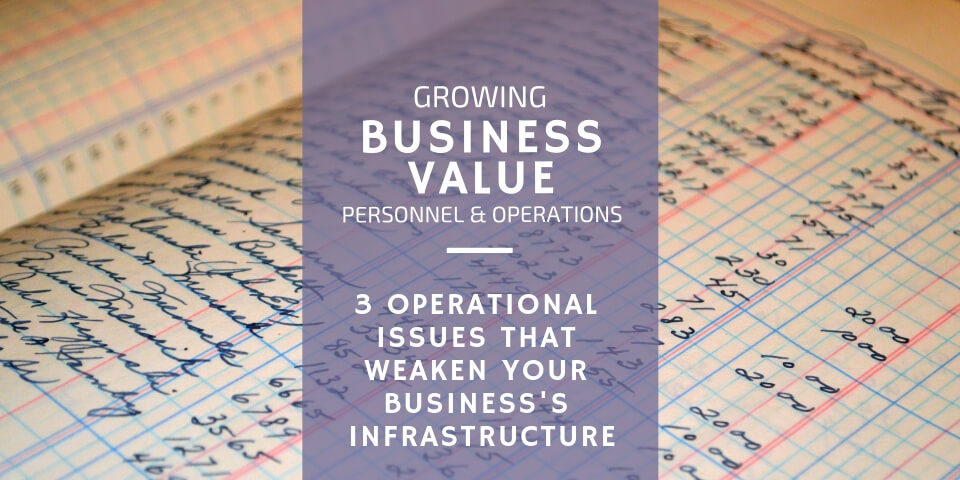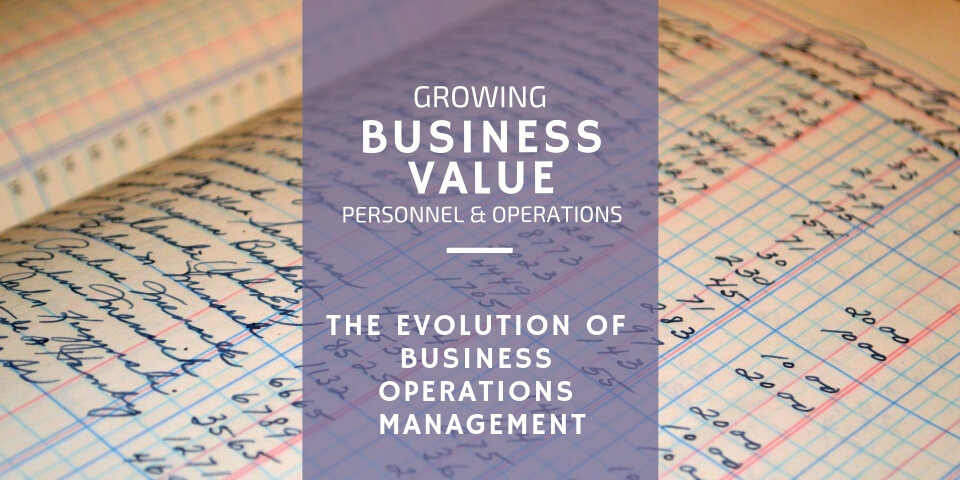
3 Operational Issues that Weaken Your Business’s Infrastructure
March 6, 2019
An Introduction to Building a Best-in-Class Finance Department
March 11, 2019History Lesson: The Evolution of Business Operations Management

Thus far in this Value Growth Series, I’ve discussed operational systems you can use and operational steps you can take in your business. Yet, in order to understand how operational systems work in your company, you need a little history lesson. Therefore, in this article, I’m going to take you through the evolution of business operations management.
Podcast Time Index for “The History of Operations Management”
00:43 – The History of Operations Management
01:32 – The Principles of Scientific Management
02:34 – Assembly Line/Parts Standardization
03:41 – Method-Time Measurement
05:52 – Toyota Production System
06:58 – Six Sigma
08:10 – ISO 9000
08:39 – Lean Operations
10:03 – The 5 Key Principles of Lean
10:46 – 8 Waste Obstacles of the Lean Process
13:26 – Business Process Re-Engineering
13:49 – 7 Components of Business Process Re-Engineering
18:44 – Next Generation Risk Management
22:08 – Summary
The Evolution of Business Operations Management
The Scientific Management Movement
The most significant developments in operations management history began at the turn of the 20th Century with the Scientific Management Movement. Led by mechanical engineer and theorist Frederick Winslow Taylor, associates in this movement proposed that employers could increase productivity if they could get employees to work smarter, not harder. Taylor spent hours upon hours studying employees’ motions so that he could produce machinery that would mirror or complement those movements. Then in 1909, he published “The Principles of Scientific Management” where he advanced his ideas about job simplification and manager-employee cooperation. Ultimately, Taylor and his associates sought to increase workplace efficiency through task optimization and team cooperation.
Introduction of the Assembly Line
Around the same time, Taylor was conducting his motion studies, Henry Ford was trying to find a way to increase his auto factories’ productivity. In order to make his car affordable to the masses, Ford knew that he had to decrease production time and manpower effort. Thus, he designed and installed the first moving assembly line in 1913 which reduced the time it took to build a car from more than 12 hours to approximately 2 and a half hours. Ford even hired Frederick Taylor to increase the efficiency of his streamlining process. Their combined efforts revolutionized the manufacturing world.
Methods-Time Measurement
World War II ushered in the next major development in business operations management. With the demand for supplies at an all-time high, employers were asking employees to quadruple their efforts in order to quadruple their output. Yet, employers had no set standards for production output, and they were pushing employees too hard. Thus, the Methods-Time Measurement System was born.
In the 1940s, Herold Bright Maynard, John Lenhard Schwab, and Gustave James Stegemerten asked researchers across the country to film employees working manufacturing jobs. Upon receiving the films, the lead researchers analyzed every hand, finger, foot, leg, head, and body motion employees performed to accomplish a given task. Then, the researchers averaged the time it took for qualified employees to complete each motion and assigned a standardized completion time to each job. This Methods-Time Measurement process helped employers know what they could realistically expect from employees. And essentially, it established the first standards for human production performance in the workplace.
Toyota Production System
After World War II, Toyota Motor Corporation led innovation in business operations management through its efforts to eliminate time and product waste. Toyota’s founder, Sakichi Toyoda, invented the concept of Jidoka when he incorporated devices on his loom machines that would stop them from running if something went wrong in the production process. Then, Kiichiro Toyoda, Sakichi’s son, developed the Just-in-Time concept which reduced excess inventory and production of inventory. Their combined efforts controlled product loss by eliminating overproduction and by eliminating poorly produced products. This new type of operations management focused on “lean production” rather than on unregulated mass production.
Six Sigma
Next, in the 1980s Motorola engineers continued improving business operations and production by creating a methodology to measure defects or irregularities in products. Rather than measuring the quality of thousands of products, they were able to measure and standardize millions of products at one time. Ultimately, this method of quality control helped companies streamline production, lower product waste, improve production time, and improve standards of production.
ISO 9000
As the Six Sigma measurement system became a global phenomenon, the International Organization for Standardization (the ISO) published a set of standards for business quality management and quality assurance in 1987. This ISO 9000 helped companies across all industries satisfy their customers’ needs, stay in compliance with regulatory requirements, and achieve continual system improvements. Essentially, it was the first quality control management system.
Lean Management
Each of these business operations management systems, theories, and methodologies built upon the previous ones, eventually morphing into what’s known as Lean Management. Introduced in 1990 in the book The Machine That Changed the World, this theory of operations management sought to improve production efficiency and quality by having companies make small, incremental changes in their processes and procedures. Using this theory of lean management, businesses make continual improvements to their operational processes to eliminate any waste of time, effort, or money.
Business Process Re-engineering
Finally, Business Process Re-engineering united Lean Management with all the other existing business management strategies. We’ll say that it put the roof on the foundation and structure that the other strategies built. BPR focused on designing business workflows and processes to improve customer service, decrease business expenses, and increase business value. Rather than focusing on streamlining one business process, BPR seeks to streamline all processes within a business to provide unparalleled service and quality.
Today
So, where are we today? Well, I see remnants of each of these processes in my company and in almost every company with which I work. I see assembly lines and compliance regulations. I see machinery working in motion with workers’ movements and employers trying to decrease the amount of time and money wasted in their businesses. Technology’s changing, and I see older business owners trying to keep up with new processes, procedures, and regulations. All of the business operations management systems still apply. However, their focus is on holistic improvements to business processes rather than improvements to one type of business process.
Look friends; I know this may be hard to wrap your mind around. However, I’ve recorded and attached a podcast to help you better understand operations management history. Listen to it if you’re lost. Ultimately, I want you to see that the processes and systems you use in your business have a historical beginning. Yet, they are still relevant today. If you manage your systems to improve your business operations, your business will become more valuable than others in your marketplace, and you will attract buyers and investors.
Continue in our Business Growth series with articles dealing with everything finance.




